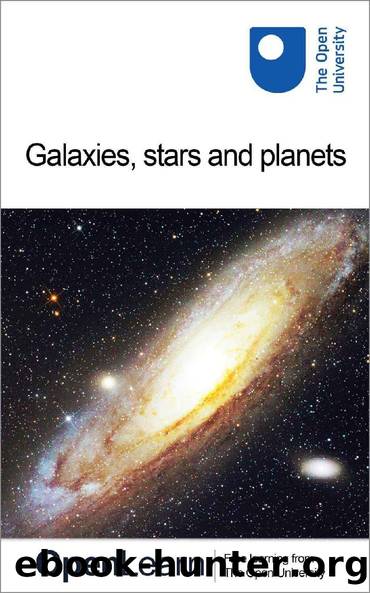Galaxies, stars and planets by The Open University

Author:The Open University
Language: eng
Format: epub
Publisher: The Open University
Published: 2016-03-01T00:00:00+00:00
5 The Sun and stars
You can experience this free course as it was originally designed on OpenLearn, the home of free learning from The Open University: http://www.open.edu/openlearn/science-maths-technology/science/physics-and-astronomy/galaxies-stars-and-planets/content-section-0.
Safety warning
Never look directly at the Sun, either with the unaided eye or through spectacles, binoculars or a telescope. You risk permanently damaging your eyes if you do so.
The part of the Sun that you normally see is called the photosphere (meaning 'sphere of light'); this is best thought of as the 'surface' of the Sun, although it is very different from the surface of a planet such as Earth. The photosphere is not solid. Rather, it is a thin layer of hot gaseous material, about 500 kilometres deep, with an average temperature of about 5500 °C or 5800 K.
Figure 8a shows a visible light image of the Sun. Sunspots (Figure 8b) appear as small dark patches on the photosphere, which typically survive for a week or so, and sometimes for many weeks. The longer-lasting sunspots can be photographed repeatedly as they cross the face of the Sun so they can even be used to investigate the rate at which the Sun rotates. The number of sunspots changes with time, gradually increasing to a maximum every eleven years then decreasing to a minimum when no sunspots may be visible for some time - a cycle intimately linked to changes in the Sun's magnetic field. A close-up view of the visible surface of the Sun (Figure 8b) also reveals a seething pattern of granules seen all across the photosphere. Individual granules, resulting from upwelling hot gas due to convection (an important process in stellar energy transport) come and go in a few minutes, often to be replaced by other granules.
Download
This site does not store any files on its server. We only index and link to content provided by other sites. Please contact the content providers to delete copyright contents if any and email us, we'll remove relevant links or contents immediately.
| Aeronautics & Astronautics | Astronomy |
| Astrophysics & Space Science | Comets, Meteors & Asteroids |
| Cosmology | Mars |
| Solar System | Star-Gazing |
| Telescopes | UFOs |
Turbulence by E. J. Noyes(7037)
Tools of Titans by Timothy Ferriss(6945)
Astrophysics for People in a Hurry by Neil DeGrasse Tyson(4618)
Room 212 by Kate Stewart(4102)
Pale Blue Dot by Carl Sagan(4001)
The David Icke Guide to the Global Conspiracy (and how to end it) by David Icke(3881)
Secrets of Antigravity Propulsion: Tesla, UFOs, and Classified Aerospace Technology by Ph.D. Paul A. Laviolette(3443)
Apollo 8 by Jeffrey Kluger(3199)
Losing the Nobel Prize by Brian Keating(3186)
A Journey Through Divination and Astronomy by Publishing Pottermore(3052)
Goodbye Paradise(2957)
COSMOS by Carl Sagan(2950)
Brief Answers to the Big Questions by Stephen Hawking(2874)
How to Read Water: Clues and Patterns from Puddles to the Sea (Natural Navigation) by Tristan Gooley(2851)
The Five People You Meet in Heaven by Mitch Albom(2839)
The Order of Time by Carlo Rovelli(2714)
How to Read Nature by Tristan Gooley(2664)
A Brief History of Time by Stephen Hawking(2473)
Aliens by Jim Al-Khalili(2381)
